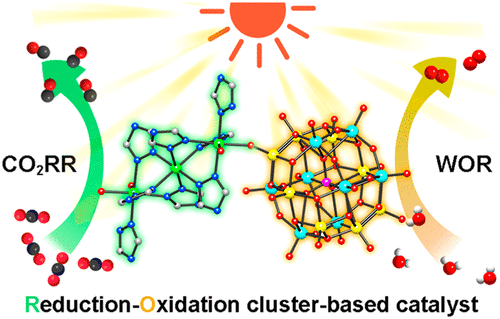Our official English website, www.x-mol.net, welcomes your feedback! (Note: you will need to create a separate account there.)
Design of Crystalline Reduction–Oxidation Cluster-Based Catalysts for Artificial Photosynthesis
JACS Au Pub Date : 2021-07-08 , DOI: 10.1021/jacsau.1c00186 Xiao-Xin Li 1, 2 , Lei Zhang 3 , Jiang Liu 3 , Lin Yuan 3 , Tong Wang 3 , Jun-Yi Wang 3 , Long-Zhang Dong 3 , Kai Huang 2 , Ya-Qian Lan 1, 3
JACS Au Pub Date : 2021-07-08 , DOI: 10.1021/jacsau.1c00186 Xiao-Xin Li 1, 2 , Lei Zhang 3 , Jiang Liu 3 , Lin Yuan 3 , Tong Wang 3 , Jun-Yi Wang 3 , Long-Zhang Dong 3 , Kai Huang 2 , Ya-Qian Lan 1, 3
Affiliation

|
Metal cluster-based compounds have difficulty finishing the photocatalytic carbon dioxide reduction reaction (CO2RR) and water oxidation reaction (WOR) simultaneously because of the big challenge in realizing the coexistence of independently and synergistically reductive and oxidative active sites in one compound. Herein, we elaborately designed and synthesized one kind of crystalline reduction–oxidation (RO) cluster-based catalysts connecting reductive {M3L8(H2O)2} (M = Zn, Co, and Ni for RO-1, 2, 3 respectively) cluster and oxidative {PMo9V7O44} cluster through a single oxygen atom bridge to achieve artificial photosynthesis successfully. These clusters can all photocatalyze CO2-to-CO and H2O-to-O2 reactions simultaneously, of which the CO yield of RO-1 is 13.8 μmol/g·h, and the selectivity is nearly 100%. Density functional theory calculations reveal that the concomitantly catalytically reductive and oxidative active sites (for CO2RR and WOR, respectively) and the effective electron transfer between the sites in these RO photocatalysts are the key factors to complete the overall photosynthesis.
中文翻译:

基于结晶还原氧化簇的人工光合作用催化剂的设计
金属簇基化合物难以同时完成光催化二氧化碳还原反应(CO 2 RR)和水氧化反应(WOR),因为在一个化合物中实现独立协同的还原和氧化活性位点共存是一个巨大的挑战。在此,我们精心设计并合成了一种结晶还原氧化 ( RO ) 簇基催化剂,连接还原 { M 3 L 8 (H 2 O) 2 } (M = Zn, Co, and Ni for RO-1 , 2 , 3分别) 簇和氧化 {PMo 9 V 7O 44 }簇通过单氧原子桥成功实现人工光合作用。这些团簇都可以同时光催化CO 2 -to-CO和H 2 O-to-O 2反应,其中RO-1的CO产率为13.8 μmol/g·h,选择性接近100%。密度泛函理论计算表明,伴随的催化还原和氧化活性位点(分别为 CO 2 RR 和 WOR)以及这些RO光催化剂中位点之间的有效电子转移是完成整体光合作用的关键因素。
更新日期:2021-08-23
中文翻译:

基于结晶还原氧化簇的人工光合作用催化剂的设计
金属簇基化合物难以同时完成光催化二氧化碳还原反应(CO 2 RR)和水氧化反应(WOR),因为在一个化合物中实现独立协同的还原和氧化活性位点共存是一个巨大的挑战。在此,我们精心设计并合成了一种结晶还原氧化 ( RO ) 簇基催化剂,连接还原 { M 3 L 8 (H 2 O) 2 } (M = Zn, Co, and Ni for RO-1 , 2 , 3分别) 簇和氧化 {PMo 9 V 7O 44 }簇通过单氧原子桥成功实现人工光合作用。这些团簇都可以同时光催化CO 2 -to-CO和H 2 O-to-O 2反应,其中RO-1的CO产率为13.8 μmol/g·h,选择性接近100%。密度泛函理论计算表明,伴随的催化还原和氧化活性位点(分别为 CO 2 RR 和 WOR)以及这些RO光催化剂中位点之间的有效电子转移是完成整体光合作用的关键因素。


























 京公网安备 11010802027423号
京公网安备 11010802027423号